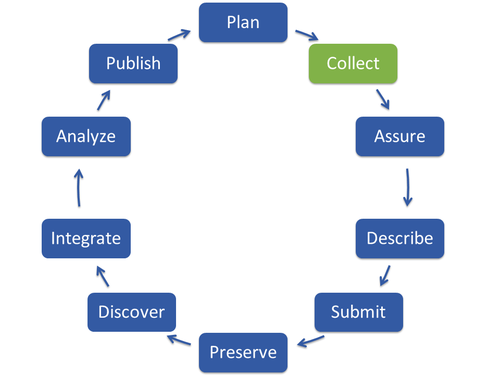Collect
What is it?
Data can be collected manually or automated in the laboratory/field or you can discover useful data through literature or repository search (see Fact-Sheet ‘Discover’). GFBio integrates workbenches and tools (e.g. Diversity Workbench, BEXIS 2) to support your data collection. Data emerge through observation, interviews, counting, measuring with instruments, or simulation by algorithms. Researchers use different technologies like tape- or video-recorders, (portable) computers/instruments, hand-written data sheets, questionnaires, tools, workbenches, satellite or aerial images.

How to do it?
- Before collecting data, set up a collection protocol/sampling strategy.
- Define which data will be created/collected (What? Where? When? Who? How?).
- Consider how many populations/individuals/samples you need to gain significant results.
- Allow for separate columns/rows per individual variable (avoid compound variables).
- Define the collection methodologies and standards (see Fact-Sheet ‘Describe’) to ensure that your data will be compatible with standards. Choose indicative, unique file names, reflecting the contents, place and time (keep it short: 20141104_birdcount_westerhever.xlsx). Document this consistent naming convention and coding that can be used by the whole research team. Maybe your institution has already recommendations, guidelines or policies for research data management and you can draw on existing structures.
- Choose appropriate software and non-proprietary formats that are suited for long-term preservation and re-use.
- Communicate your collection protocol to the involved team.
- Gain comprehensive knowledge about the item to be collected and its habitat/occurrence.
- Organize the logistics, e.g. gain collection permits (if required).
- Set up a backup plan and save your data on secure and geographically dispersed servers.
- In case you created a commonly used vocabulary or a classification to describe your primary research objects, this can be submitted as a terminology to the GFBio Terminology Service for reuse.
Who does it?
Currently every data producer integrating other data or creating own data within his/her research project or as partner in a research program.
Key Elements
- Use workbenches and tools to collect data in a consistent, systematic manner throughout the study (reliability).
- Capture and create structured Metadata (e.g. EML, ABCD, see Fact-Sheet ‘Describe’).
- Back up your data on geographically dispersed servers.
GFBio Services
Data Collection and Assurance
- Collaboration with e.g. Diversity Workbench (DWB) and BExIS2 for a smooth data transfer to GFBio
- Example data submission templates for biodiversity, ecological and collection data as well as molecular sequence data
Useful Links
https://www.dataone.org/best-practices (Best-Practices-Primer)
http://www.abctaxa.be/volumes/volume-8-manual-atbi/chapter-7/Chapter_7.pdf (tissue collection)
http://www.dcc.ac.uk/training/train-the-trainer/dc-101-training-materials (for a deeper understanding)
http://www.diversitymobile.net (tool which helps to record data in the field)
https://www.youtube.com/watch?v=nNBiCcBlwRA (nice video about what can go wrong – not only in medical science!)
Recommended citation:
German Federation for Biological Data (2021). GFBio Training Materials: Data Life Cycle Fact-Sheet: Data Life Cycle: Collect. Retrieved 16 Dec 2021 from https://www.gfbio.org/training/materials/data-lifecycle/collect.